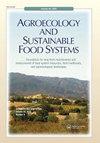用于乳制品和食品的加速降解的现代生物可降解材料(主题审查)
IF 2.6
3区 农林科学
Q1 AGRICULTURE, MULTIDISCIPLINARY
Agroecology and Sustainable Food Systems
Pub Date : 2023-04-07
DOI:10.21323/2618-9771-2023-6-1-11-21
引用次数: 0
摘要
聚合物工业的产品,其中大部分是食品包装,对环境造成了重大威胁,这需要寻找最有效和功能的解决方案来解决这个问题。每年,聚合物包装的产量平均增长10-12%,去年,由于新冠肺炎(COVID-19)及其菌株在全球传播,产量增长超过20%。使用主要的基本方法解决环境问题是可能的:处置和回收废物,这将使已经使用的聚合物有可能获得“第二次生命”;开发和创造新的可生物降解材料,能够在外部因素的影响下完全降解为相对安全的物质。然而,应该指出的是,第一种方法有许多与难以控制所进行的再循环过程的数量有关的重大缺点,这可能导致从聚合物材料迁移过程的增加。解决包装处理和回收的环境问题的第二种方法是与创造聚合物材料相关的方向,用不同浓度的有机和无机填料取代部分传统的商业合成基。然而,在我们看来,处理包装废弃物最有希望的方法是开发旨在创造具有可调节使用寿命的完全可生物降解材料的技术,这些材料在其生命周期后,可以在短时间内处理而不损害环境。本文分析了现代生物可降解材料的市场和获得可降解成分的方法,这些可降解成分可以成为传统塑料的重要替代品。本文章由计算机程序翻译,如有差异,请以英文原文为准。
Modern biodegradable materials with accelerated degradation for dairy and food products (subject review)
Products of the polymer industry, the lion's share of which is food packaging, create a significant threat to the environment, which requires a search for the most effective and functional solutions to this problem. Every year, the production of polymer packaging is growing by an average of 10-12%, and last year, due to the worldwide spread of SARS-CoV-2 (COVID-19) and its strains, the increase was more than 20%. A solution to the environmental problem is possible using the main basic approaches: disposal and recycling of waste, which will give the possibility of the “second life” to already used polymers; development and creation of new biodegradable materials capable of degrading completely under the influence of external factors into relatively safer substances. However, it should be noted that the first method has a number of significant drawbacks associated with the difficulty in controlling the amount of recycling processes carried out, which can potentially lead to an increase in migration processes from polymeric materials. The second way to solve the environmental problem of packaging disposal and recycling is the direction associated with the creation of polymeric materials with the replacement of part of the traditional commercial synthetic bases with organic and inorganic fillers in various concentrations. However, the most promising way to handle packaging waste, in our opinion, is the development of technologies aimed at creating fully biodegradable materials with a regulated service life, which, after their life cycle, are disposed of in a short time without harming the environment. This review is devoted to the analysis of the market of modern biodegradable materials and methods for obtaining degradable compositions that can become a significant alternative to traditional plastics.
求助全文
通过发布文献求助,成功后即可免费获取论文全文。
去求助
来源期刊

Agroecology and Sustainable Food Systems
AGRICULTURE, MULTIDISCIPLINARY-GREEN & SUSTAINABLE SCIENCE & TECHNOLOGY
CiteScore
4.80
自引率
7.70%
发文量
73
期刊介绍:
Agroecology and Sustainable Food Systems is devoted to the rapidly emerging fields of agroecology and food system sustainability. By linking scientific inquiry and productive practice with transformative social action, agroecology provides a foundation for developing the alternative food systems of the future. The journal focuses on the changes that need to occur in the design and management of our food systems in order to balance natural resource use and environmental protection with the needs of production, economic viability, food security, and the social well-being of all people.
Agroecology and Sustainable Food Systems examines our current food systems from production to consumption, and the urgent need to transition to long-term sustainability. The journal promotes the study and application of agroecology for developing alternatives to the complex problems of resource depletion, environmental degradation, a narrowing of agrobiodiversity, continued world hunger, consolidation and industrialization of the food system, climate change, and the loss of farm land. The journal uses a food systems approach, and seeks experiences in agroecology that are on-farm, participatory, change-oriented, and backed by broad-based methodologies of sustainability analysis and evaluation.
 求助内容:
求助内容: 应助结果提醒方式:
应助结果提醒方式:


